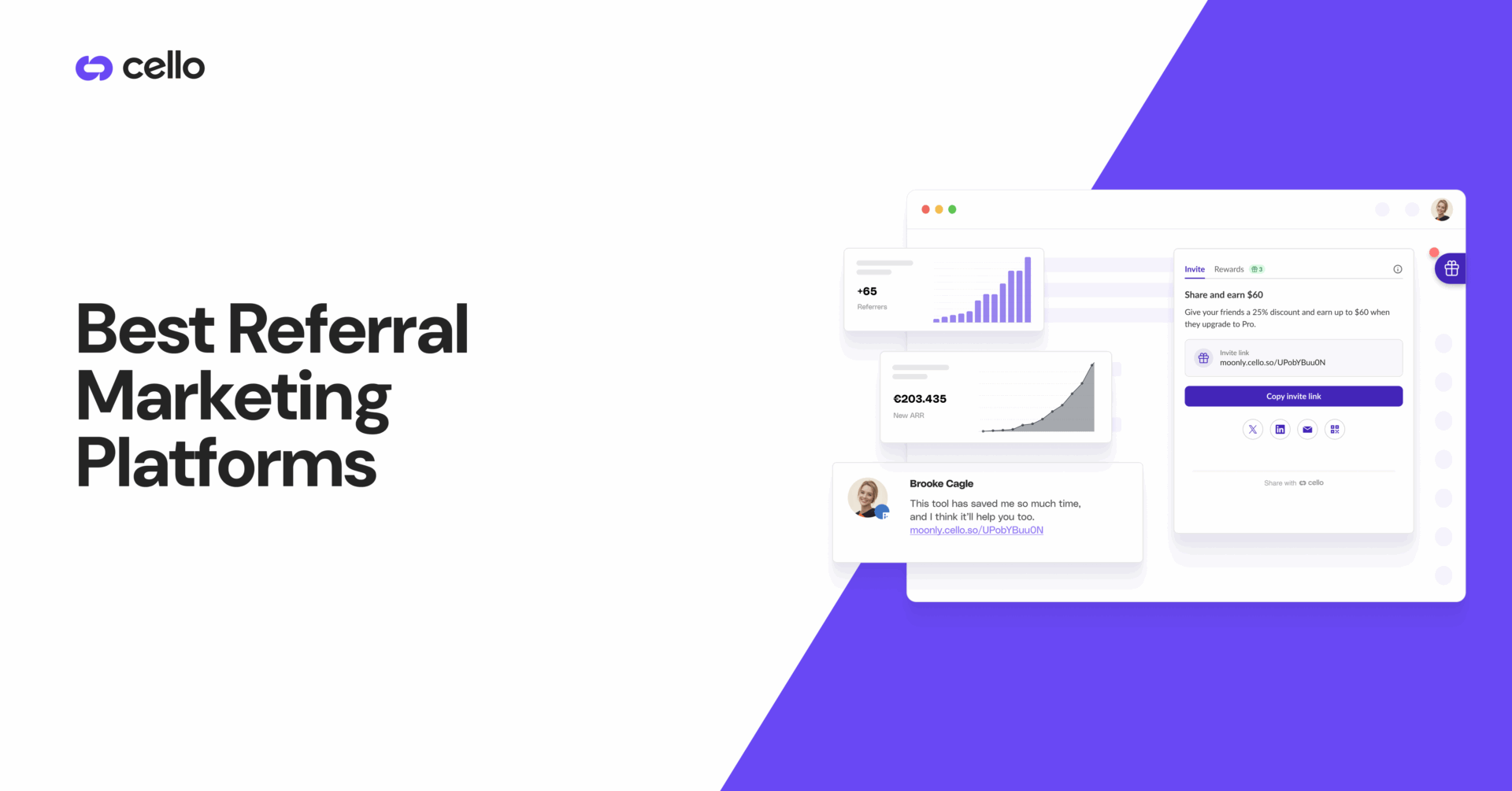TL;DR: For B2C & B2B SaaS Companies, Cello is the top referral marketing choice due to its native in-product experience, which drives higher engagement. Its server-side tracking ensures accuracy, and it automates payouts and compliance. For large partner ecosystems, consider PartnerStack.
- Top Referral Marketing Software for SaaS
- Quick Comparison Table of Referral Marketing Platforms
- Key Features That Matter for SaaS Referral Marketing
- Benefits of Automated Referral Programs Over In-House Builds
- Emerging Trends in Referral Marketing Software
- Implementation Checklist for Launching a Referral Marketing Program
- Accelerate Growth With User-Led Referrals Powered by Cello
Top Referral Marketing Software for SaaS
Choosing the ideal referral program software for a SaaS company is critical because word-of-mouth is one of the most powerful acquisition channels.
According to Nielsen's Trust in Advertising study, 88% of consumers trust recommendations from people they know more than any other form of advertising (Source). These referred customers are also more valuable, with a study from the Wharton School of Business finding their lifetime value to be 16% higher than non-referred customers (Source).
This means focusing on platforms that deliver high performance, robust automation, and pinpoint tracking accuracy. The best solutions seamlessly embed into your product, automate complex tasks like payouts and compliance, and provide reliable attribution that works beyond browser-based cookies.
Here are the top contenders for 2025:
Cello
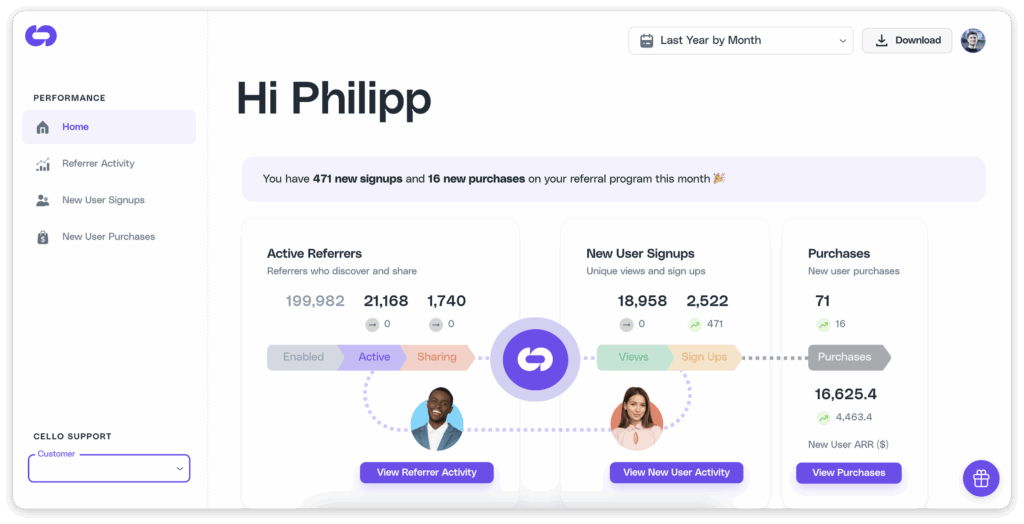
Cello is a referral marketing platform purpose-built for B2B and B2C SaaS companies. Its core architecture is designed for in-product referrals, creating a seamless user experience that drives significantly higher engagement and conversion rates. Cello specializes in native in-app referral flows, automated engagement journeys, server-side tracking, and fully integrated payout systems.
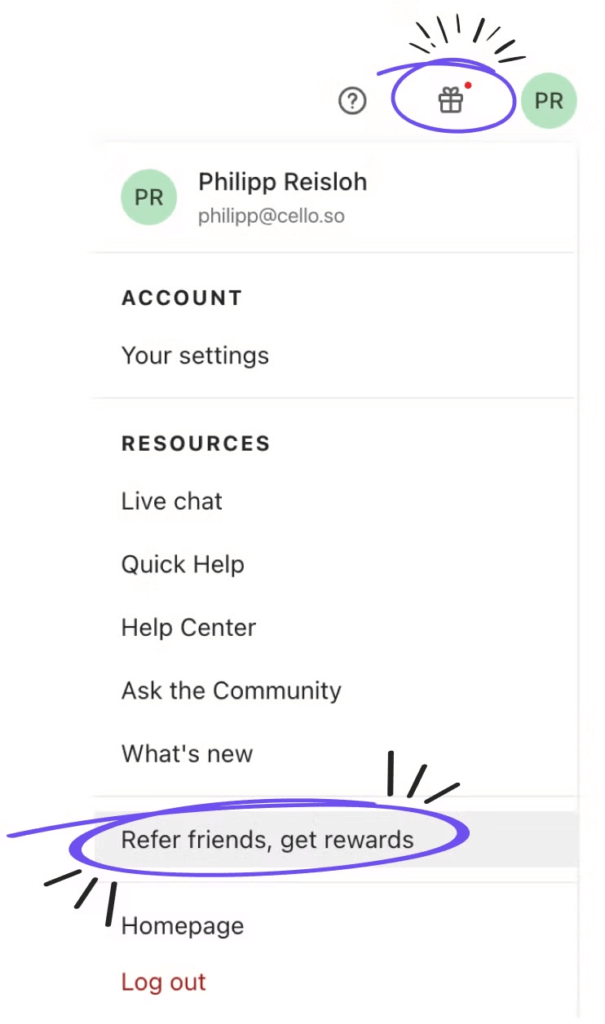
In-product Referral as Core Architecture: Cello was built from the ground up for native, in-app referral experiences. Its Referral Component functions as a first-class part of your product’s UX, allowing your users to share, track progress, and redeem rewards without ever leaving your interface. This integrated approach makes the referral program feel like a core feature, not a third-party add-on.
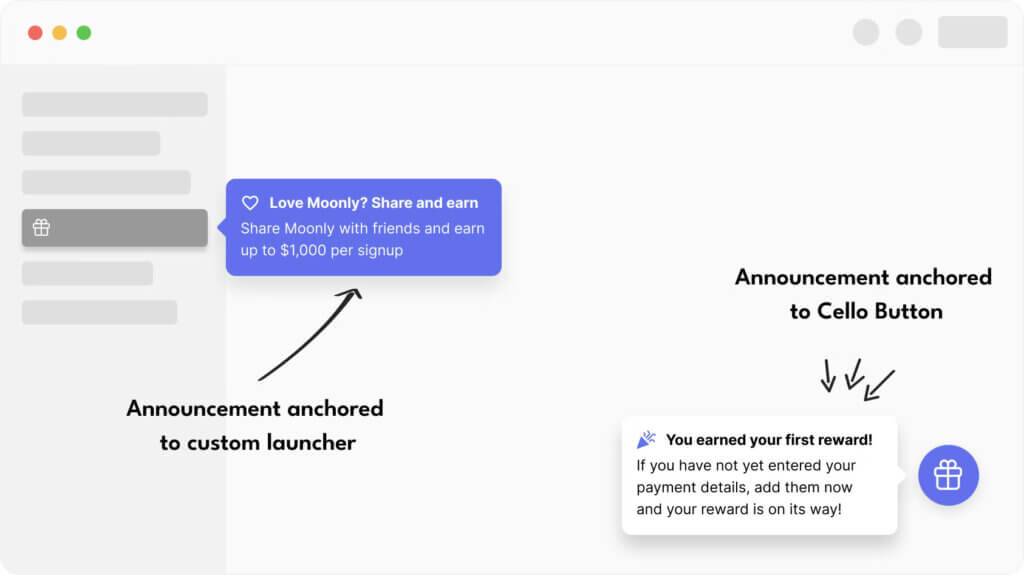
Notifications & Engagement Journeys: The platform delivers coordinated in-app and email journeys to keep users engaged. Cello has built-in badges, alerts, and lifecycle emails triggered by key referral milestones (e.g., first share, reward earned). The timing is behavior-driven and fully configurable without requiring extra infrastructure or custom code.
Attribution: Client vs. Server Tracking: Cello’s backend-centric attribution model provides a more reliable and secure tracking method compared to traditional client-side scripts.
| Topic | Cello | Competitors |
|---|---|---|
| Tracking model | Backend-centric attribution using secure IDs and event webhooks (e.g., Stripe). No reliance on cookies or client-side scripts. | Client-side cookie tracking by default. Support API-only mode, but require custom setup. |
| Conversion flow | Ties referrals to backend payment events via Stripe metadata or API payloads. Deterministic matching even in blocked or mobile environments. | Attribute sales by matching customer emails from client-recorded leads to billing events. Sensitive to missing cookies or mismatched emails. |
| Resilience | Works in privacy-restricted or JS-disabled environments. Ideal for mobile, embedded, or secure checkout flows. | Dependent on browser state; cookie-less tracking requires custom logic. |
Cello also automates the entire end-to-end payout process. Users can select their preferred payout methods (like PayPal or Venmo) directly within the app, and rewards are triggered or queued automatically. Additionally, Cello supports credit-based rewards, a pricing model gaining popularity with AI and usage-based SaaS companies.
Where Cello outperforms:
- Embedded referral UX: A native in-app component versus an external affiliate portal.
- Automated engagement: Integrated in-app and email journeys without needing custom code.
- Server-side reliability: Deterministic attribution that doesn't depend on browser scripts.
- Unified reward logic: Multi-type, double-sided incentives are configurable in a single campaign.
- Integrated payouts: The complete payout flow is handled within your app experience.
Where Cello might lack: Not suitable for companies looking for a highly sophisticated Partner Relationship Management (PRM) platform for managing complex channel sales.
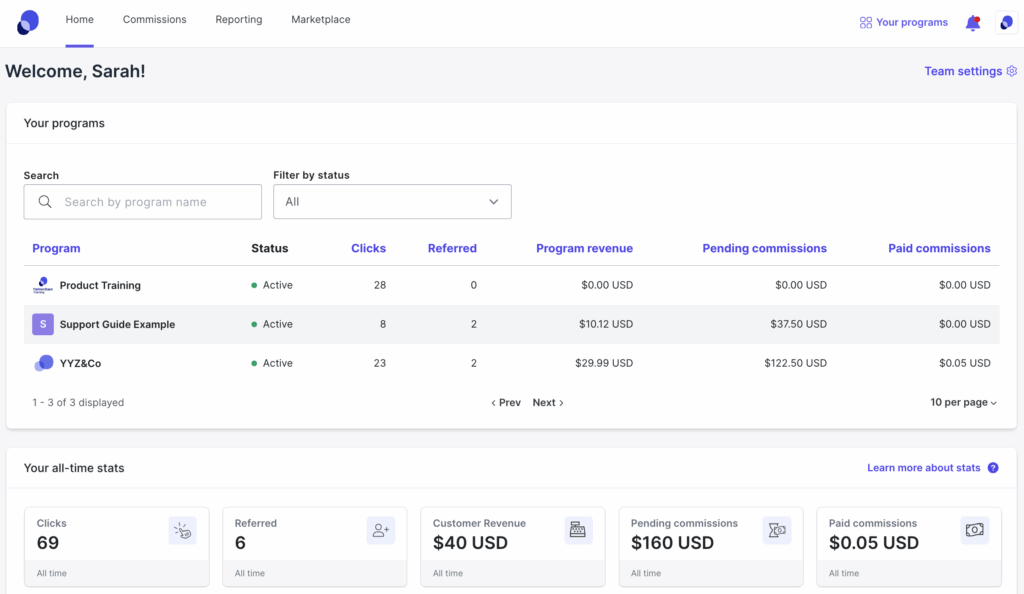
PartnerStack is a powerful platform focused on managing a complete partner ecosystem, including resellers, affiliates, and channel partners. It's an enterprise-grade solution well-suited for larger SaaS companies that need to manage various types of partnerships beyond simple customer referrals.
However, PartnerStack’s experience lives in an external portal. This means your users are forced to leave your product and go to a separate dashboard just to grab a link or track their progress. That extra step creates friction and can kill engagement, leading to a lower-performing program compared to Cello's seamless in-app component. Because its tracking is primarily JavaScript-based, it can be less reliable in privacy-restricted environments where scripts might be blocked.
Furthermore, all notifications are handled via webhooks and external email triggers, requiring manual work to build custom user journeys.
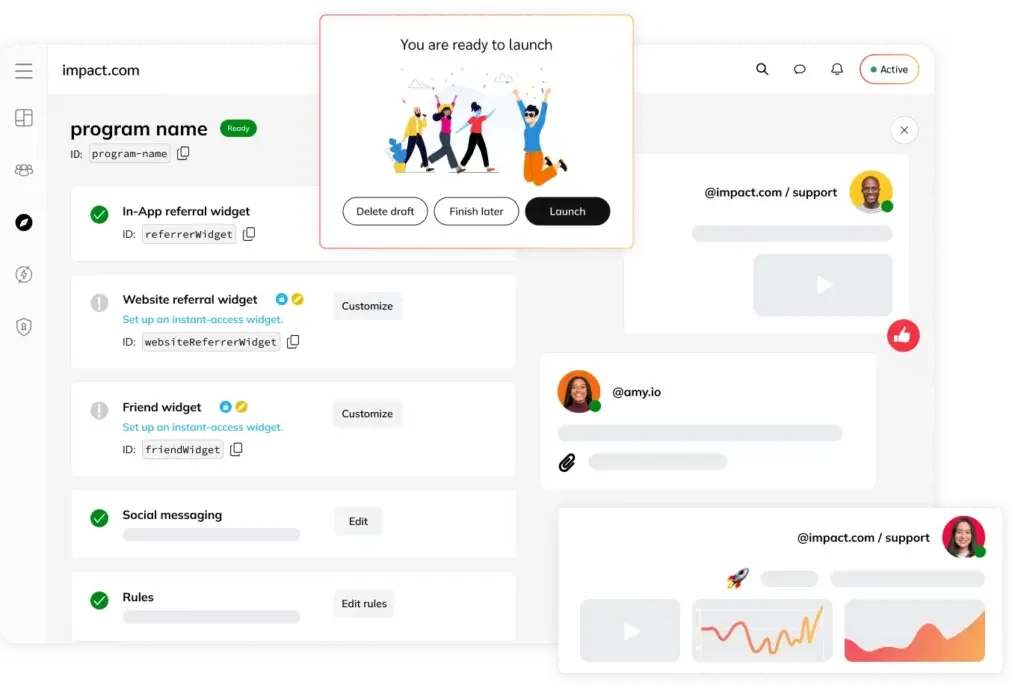
Impact Advocate (formerly SaaSquatch) is an enterprise-grade platform known for its scalability, advanced attribution modeling, and comprehensive partnership management features. It’s designed for large companies that need to manage complex loyalty, referral, and affiliate programs under one roof.
Advocate provides embeddable widgets via squatch.js. While customizable, these are external components loaded into your page, not native UI. Achieving a seamless look and feel often requires significant design and development work.
Like other platforms, Advocate lacks a native in-app notification framework, relying on event webhooks and external systems to create engagement loops.
While it can be configured for server-side tracking, its default setup is more client-dependent than Cello’s, requiring more manual configuration to achieve the same level of reliability.
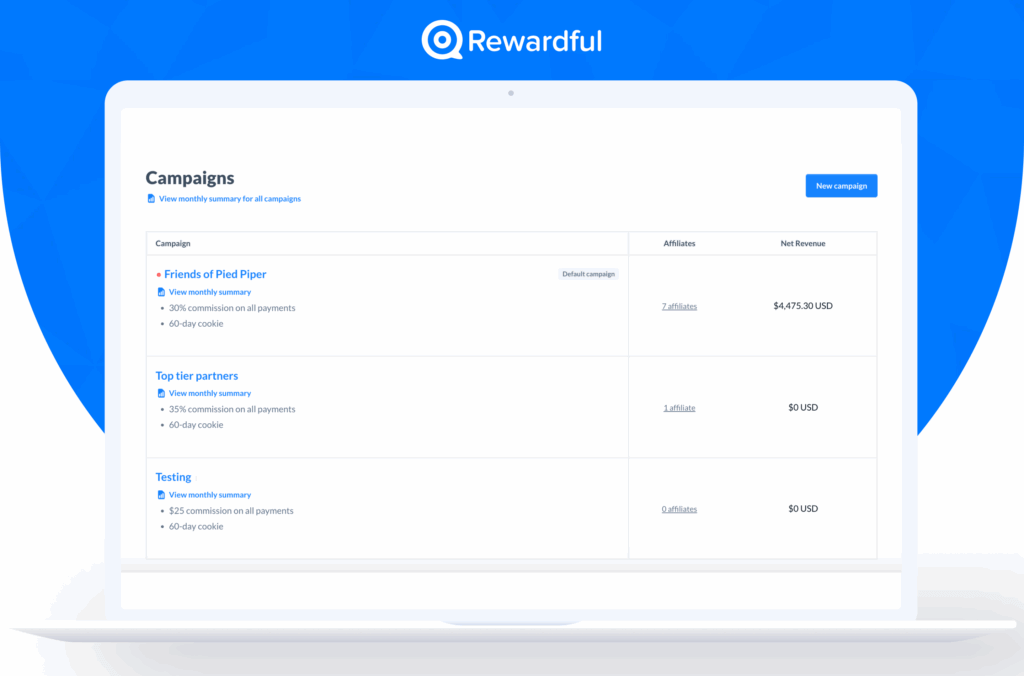
Rewardful is a simple and straightforward platform that is particularly popular among smaller SaaS teams and those using Stripe. Its direct integration with Stripe makes it incredibly easy to set up for subscription-based businesses. The focus is on simplicity and affiliate management.
However, its reliance on a JavaScript snippet and an external portal means the referral experience is not deeply integrated into the product. This can lead to attribution gaps in environments with script blockers, and its client-side tracking is inherently less accurate than Cello's server-to-server approach.
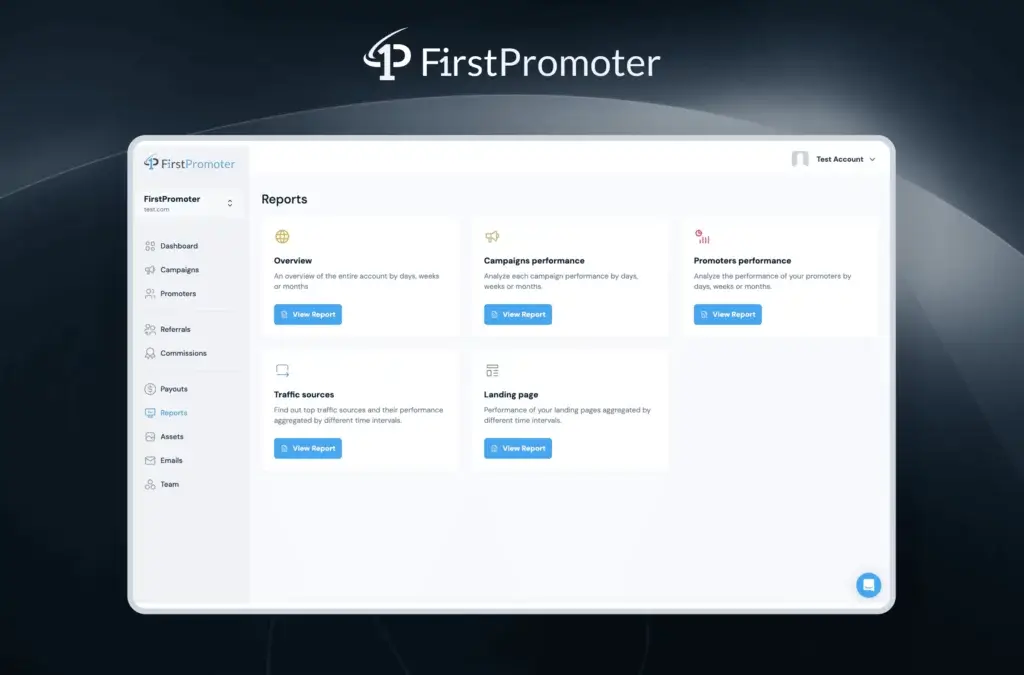
FirstPromoter is a developer-friendly platform with a strong focus on affiliate program management. It offers features like lifetime deal tracking and a robust API for custom integrations.
It provides a hosted affiliate portal, but like many others, it lacks a pre-built in-product UI, requiring developers to link out or embed the portal.
Notifications are handled via email and webhooks, meaning any in-app engagement must be custom-built. Payouts are aggregated in its dashboard and must be executed manually by an administrator.
Tapfiliate
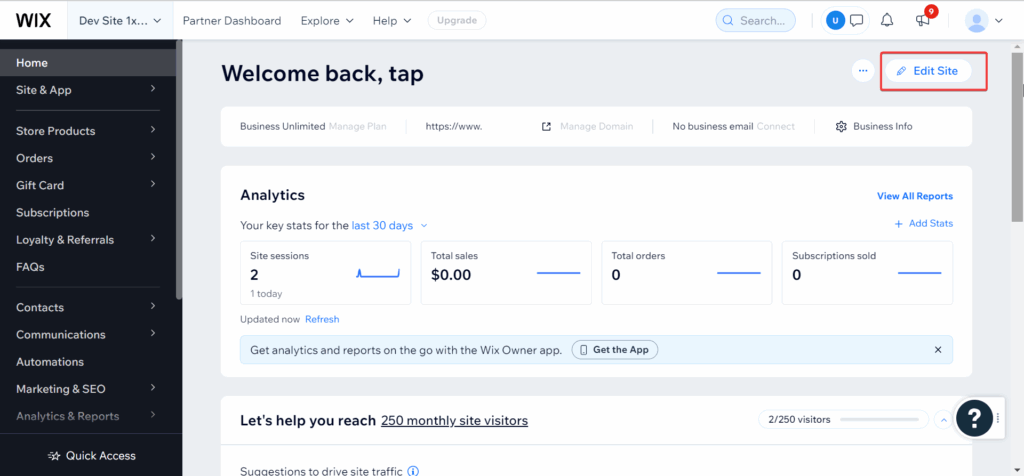
Tapfiliate is a versatile affiliate and referral marketing software that offers powerful features like multi-tier marketing, where affiliates can recruit other affiliates.
It provides white-label options, allowing businesses to customize the affiliate portal to match their brand. Its strength lies in its comprehensive reporting dashboard and flexibility for creating complex commission structures.
ReferralCandy
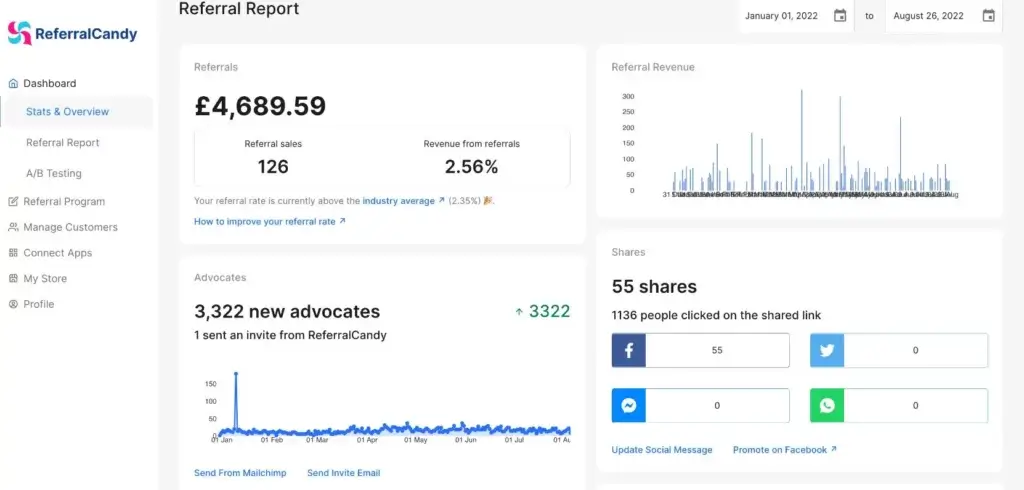
With roots in e-commerce, ReferralCandy has adapted its platform for SaaS companies. It is known for its simplicity and "set it and forget it" approach, powered by automated email campaigns.
For businesses looking for a straightforward, Shopify-style experience for their referral program, ReferralCandy is a strong contender. However, it may lack the deep customization and B2B-specific features required by more complex SaaS products.
GrowSurf
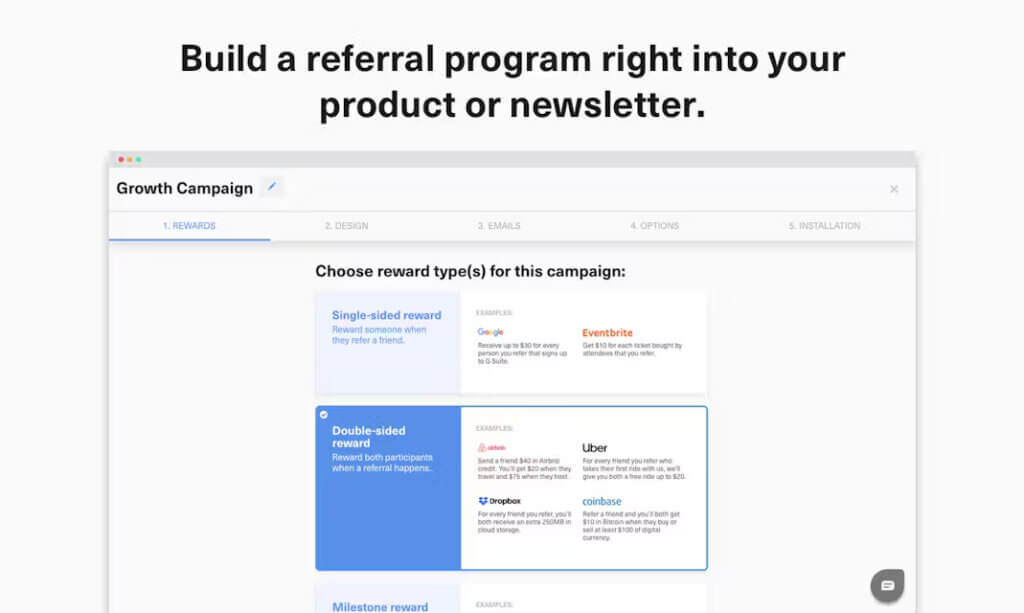
GrowSurf is a modern referral marketing platform designed to help businesses create viral loops. It has a clean user interface and is particularly popular with startups due to its friendly pricing and focus on growth hacking techniques.
It provides tools to optimize sharing and track viral coefficients, but its core architecture is not as deeply embedded in-product as specialized SaaS solutions.
Quick Comparison Table of Referral Marketing Platforms
| Platform | Best For | Key Strength | Starting Price | Setup Time |
|---|---|---|---|---|
| Cello | B2C & B2B SaaS | Native in-product UX & server-side tracking | $200/mo (annual plan) | Hours to Days |
| PartnerStack | Enterprise, Partner-driven SaaS | Channel partner ecosystem management | Custom | Weeks to Months |
| Impact Advocate | Enterprise Scale | Advanced attribution & partnership types | Custom | Weeks to Months |
| Rewardful | Early-Stage SaaS | Simplicity and Stripe integration | From $49/mo | Days |
| FirstPromoter | Affiliate Programs | Developer-friendly API & lifetime tracking | From $49/mo | Days to Weeks |
| Tapfiliate | Multi-Level Marketing | Multi-tier tracking and white-labeling | From $89/mo | Days |
| ReferralCandy | Simple SaaS/E-comm | Automated email campaigns & ease of use | From $59/mo | Days |
| GrowSurf | Startups | Viral loop optimization & modern UI | From $99/mo | Days |
Key Features That Matter for SaaS Referral Marketing
SaaS referral programs have different needs than their e-commerce counterparts. Longer sales cycles, higher customer lifetime values, and strict compliance requirements demand a more sophisticated feature set.
Referral Performance
A referral program's performance can vary dramatically based on the platform you choose. The user experience is paramount. An intuitive, in-product referral widget can increase activation by up to 400% compared to an external portal because it reduces friction and keeps the user engaged within your product ecosystem (source).
Referral Tracking Accuracy
Nothing is more frustrating than a lead that came from a referral but didn't get tracked properly. Especially for B2B, sales cycles are messy, and cookie-based methods just can't keep up. That's why server-side tracking is a non-negotiable feature. It connects referrals directly to backend billing events, so you get foolproof attribution even if users switch devices or use ad blockers.
Automated Payouts and Tax Compliance
Manually processing payouts is inefficient and risky. A top-tier platform automates payouts in multiple currencies and handles tax compliance by generating required documents like 1099s. This saves countless administrative hours and ensures you remain compliant as your program scales globally.
Fraud Detection and Security
Referral fraud can devalue your program. Essential security features include IP blocking, velocity checks to monitor the rate of referrals from a single source, and manual review triggers for suspicious activity. Advanced platforms use machine learning to detect fraudulent patterns automatically.
In-Product Widget and API Flexibility
A native user experience is critical for SaaS. The ability to embed a referral widget directly into your application drives much higher engagement than linking out to an external landing page. A flexible API is also crucial for creating custom integrations and workflows tailored to your product.
Multi-Tier and Usage-Based Rewards
SaaS referrals often warrant more complex reward structures. Multi-tier programs can reward advocates for the initial referral and subsequent milestones. Usage-based rewards, where payouts are tied to the referred customer's consumption (e.g., API calls, data storage), are becoming increasingly popular for PLG and AI companies.
CRM and Billing Integrations
Seamless integration with your existing tech stack is a must. Critical integrations include your CRM (Salesforce, HubSpot) for tracking leads and your billing system (Stripe) for accurate conversion attribution. These connections ensure data flows automatically, providing a single source of truth for program performance.
Benefits of Automated Referral Programs Over In-House Builds
While building a referral program in-house may seem appealing, the "build vs. buy" decision often favors a specialized platform for several reasons:
- Speed to market: Launching with a dedicated platform can take weeks, whereas custom development can take many months of precious engineering resources.
- Compliance handling: Pre-built platforms come with support for tax (1099s) and privacy regulations (GDPR, CCPA), mitigating significant legal and financial risks.
- Plays nice with your existing tools: Why reinvent the wheel? You get an entire ecosystem of pre-built connections to tools you already use, like Stripe and HubSpot. This means your dev team can focus on your core product, not on building and maintaining integrations.
How to Choose the Best Referral Marketing Software for Your SaaS
Follow this framework to evaluate and select the right platform for your business.
Define Growth Goals and KPIs
Start by identifying what you want to achieve. Are you focused on reducing customer acquisition costs (CAC), increasing referral conversion rates, or improving customer lifetime value (LTV)? Clear KPIs will help you measure program ROI.
Map Mandatory Integrations
Audit your existing tech stack. Identify the must-have integrations, such as your CRM, billing platform, and marketing automation software. Ensure the platform you choose has robust APIs for any custom needs.
Evaluate Compliance and Security Needs
Assess your regulatory requirements. Do you need to be GDPR or CCPA compliant? Do you serve enterprise customers who require SOC 2 certification? Ensure the platform meets your data residency and security standards.
Emerging Trends in Referral Marketing Software
The referral marketing landscape is constantly evolving. Here are the key trends to watch.
Credit-based rewards
With the rise of usage-based pricing in AI and other SaaS sectors, credit-based rewards are becoming essential. Instead of cash, advocates are rewarded with credits that can be applied to their own subscriptions, which boosts retention and reduces cash payouts. Cello is the first referral marketing platform to offer credit-based rewards, in line with growing industry trends.
AI-Powered Fraud Detection
Platforms are increasingly using machine learning algorithms to identify and prevent referral fraud. AI can recognize complex patterns of abuse in real-time, providing more robust protection than manual rule-based systems.
Multi-Currency Payout Automation
As SaaS companies become global from day one, the need to support international advocates is critical. Modern platforms are integrating with global payment providers to automate payouts in multiple currencies, handling conversion rates and compliance seamlessly.
Privacy-First Tracking Without Cookies
With the deprecation of third-party cookies, privacy-first attribution is the future. Server-to-server tracking, which relies on first-party data and direct integration with billing systems, is becoming the gold standard for accurate and compliant referral attribution.
Implementation Checklist for Launching a Referral Marketing Program
Follow these steps to ensure a smooth launch.
1. Connect Billing and CRM Data Sources
Start by setting up the core API connections to your billing platform (e.g., Stripe) and CRM (e.g., HubSpot). Map the data fields correctly and test the data flow to ensure accuracy.
2. Configure Reward Logic and Limits
Define the rules of your program. Set the payout amounts, specify the qualification criteria (e.g., a referred customer must be active for 30 days), and configure fraud prevention rules and budget caps.
3. Embed Referral Widget or API
Work with your development team to implement the referral component. Whether you use a pre-built embeddable widget or the platform's API, focus on creating a seamless and intuitive user experience that feels native to your product.
4. Test Attribution End-to-End
Thoroughly test the entire referral flow. Create test accounts to simulate different scenarios, such as a user clicking a link, signing up, and converting to a paid plan. Verify that the referral is tracked accurately at every step.
5. Launch and Monitor Real-Time Dashboards
Once you go live, closely monitor your program's performance using the platform's real-time dashboards. Track your KPIs and be prepared to iterate on your reward structure, messaging, and promotion strategy to optimize results. Cello customers can schedule regular calls with Cello's Customer Success and Growth teams to optimize their referral marketing performance.
Accelerate Growth With User-Led Referrals Powered by Cello
Stop settling for referral programs that feel disconnected and don't deliver. Cello is built for how modern SaaS companies grow: from within the product itself. With a seamless user experience, tracking that actually works, and automation that saves you time, Cello delivers a powerful growth engine that you can launch in hours, not weeks.
Start your referral program today. Book a demo and launch your referral program in under a week.
You mention a "native in-product" experience. Does that mean we have to build the referral UI from scratch?
Not at all. When we say "native," we mean the experience feels like it belongs in your app, but you don't have to code it from the ground up. We provide a pre-built, fully customizable Referral Component that you simply embed into your product (similar to how you might embed a Stripe payment element). You can style it to match your brand perfectly, so it looks like you spent months building it, but it only takes a few hours to implement.
Why is "server-side tracking" such a big deal? My current tool uses cookies and seems fine.
ookie-based tracking is becoming obsolete and unreliable. Modern browsers (like Safari and Chrome) are actively blocking third-party cookies, and many tech-savvy SaaS users run ad blockers that kill client-side scripts. This means you are likely paying for referrals you can't track—or worse, failing to reward partners who earned it. Cello’s server-side tracking connects directly to your backend (e.g., Stripe), so attribution is 100% accurate, immune to ad blockers, and compliant with privacy laws.
I have both regular users and professional affiliates. Do I need PartnerStack for the affiliates and Cello for the users?
No, you can handle both with Cello. While PartnerStack is optimized for massive reseller ecosystems (like VARs or agencies), Cello is built to unify User Referrals and Affiliates in one platform. You can create different campaigns with different reward structures—for example, giving users 20% off their bill while giving professional affiliates a 30% cash commission—all managed from a single Cello dashboard.
We are a product-led growth (PLG) company. Can we reward users with "credits" or "free months" instead of cash?
Absolutely. In fact, this is where Cello shines for PLG and AI companies. Because we integrate deeply with your billing provider (like Stripe), we can automatically apply credits, discounts, or free usage months to a user's subscription as a reward. You don't have to manually update their account; Cello handles the logic instantly when a referral converts.
If we offer cash rewards, do we have to collect tax forms (like 1099s) manually?
No, we automate that compliance burden for you. Cello acts as the Merchant of Record for rewards. We handle the collection of tax information, generate the necessary tax documents (like 1099s for US recipients), and ensure payouts are compliant across different geographies. Your finance team won't have to chase down tax forms from your advocates.
Our sales cycle is long (3+ months). Can Cello still attribute the referral correctly after that much time?
Yes. Because we use server-side attribution rather than temporary browser cookies, our tracking is "sticky." When a lead is referred, we bind that referral data to their customer record in your backend. Whether they convert in 3 days or 3 months, Cello recognizes the link when the billing event finally happens and triggers the reward.
We use Stripe for billing. How complicated is the integration?
It’s incredibly straightforward. Cello is designed as a "Stripe-first" platform. You essentially just connect your Stripe account via our dashboard, and we automatically listen for events like subscription.created or invoice.paid. There is no complex custom code required to "teach" Cello when a sale happens—we see it the moment Stripe sees it.
I’m worried about fraud. What prevents users from referring themselves to get rewards?
We have built-in fraud protection to stop "self-referrals." Cello uses advanced fingerprinting and logic checks to identify if a referrer and a new lead are actually the same person (checking IP addresses, device IDs, and payment methods). You can also set up "velocity limits" to flag if one user suddenly refers an impossibly high number of people in a short time, allowing you to review them manually before any money goes out.
We already have a program on Rewardful/FirstPromoter. Is it hard to switch to Cello?
Migrating is easier than you think. We can help you import your existing affiliates and their tracking links so their old links continue to work. The biggest switch is moving from their external portal to our embedded experience, which usually results in an immediate boost in engagement. Plus, since we don't rely on the fragile cookies those platforms use, you'll likely see an immediate improvement in tracking accuracy.
